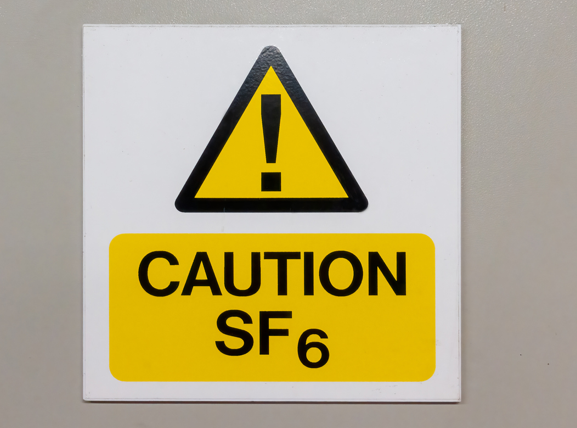

When people talk about greenhouse gas (GHG) emissions, the focus is usually on carbon dioxide or methane. These two gases make up about 90% of the GHGs that cause climate change. But there are a number of others that climate scientists monitor. Among them is sulfur hexafluoride, or SF6, a colorless, odorless gas used as an insulator in power substations. Though its prevalence in the atmosphere is small, it has the potential to make an outsized impact. That’s because it is the most potent GHG, with 23,500 times the global warming potential of carbon dioxide.
Researchers in the power and energy sector where it is used have devoted significant effort to finding replacements.
WHAT DOES SF6 DO?
Sulfur hexafluoride is a very powerful insulator that has been used for decades to prevent short circuits and electrical arcing in electrical substation equipment, like high voltage switchgear and transformers. It’s stable, nontoxic, and has a low level of flammability, all properties that have made it applicable to a wide range of operating environments and voltage levels in the power industry.
“SF6 has been used globally as a very efficient insulation gas,” said IEEE Senior Member Guilherme Susteras, “which means that utilities globally could build electrical power stations and substations in a more compact fashion. This is especially important in urban settings, where physical space can be a serious constraint for network expansion.”
WHAT’S THE IMPACT OF SF6?
Every pound of SF6 released into the atmosphere is equivalent to the carbon impact of two cars on the road per year, or 1,100 gallons of gasoline, or burning 11,000 pounds of coal, according to an online calculator developed by the U.S. Environmental Protection Agency. And because it’s so stable – meaning it doesn’t mix with other compounds – it lasts for a long time in the atmosphere, around 3,200 years. Methane, for comparison, remains in the environment for about 12 years.
India is a significant user of SF6 in the Industrial Processes and Product Use (IPPU) category, and in particular the power transmission and distribution, with SF6 accounts for 0.04 percent of the GHG emission in the IPPU category. The Indian government has set targets for reducing greenhouse gas emissions, including from SF6. Earlier in 2016, the Government of India submitted its Biennial Update Report (BUR) to the United Nations Framework Convention on Climate Change (UNFCCC). The BUR inventory covered six greenhouse gases. Among them, Sulfur Hexafluoride (SF6) is identified as a GHG, and its use in five categories, [energy, IPPU, agriculture, waste and Land-use, Land-use, Change, and Forestry (LULUCF)] is identified for the reduction in use.
Estimates vary pretty significantly about how much SF6 is emitted every year. But measurements of its presence in the atmosphere show it is growing – from four parts per trillion in 2000 to about 11 parts per trillion in 2021.
HOW DOES IT ENTER THE ATMOSPHERE?
The power and electrical industry accounts for 70%-80% of the total SF6 gas emissions, according to IEEE Senior Member Ling Wang. Typically, the gas is usually used in sealed units, which can leak during production, maintenance and decommissioning.
WHAT’S BEING DONE ABOUT IT?
SF6 was first identified as a GHG of concern as part of the Kyoto Protocols in 1997 – the international agreement that represented the first binding GHG reduction targets for industrialized countries. That set off a broad effort to reduce its use. Power equipment, for example, was redesigned to use significantly less over the years. And power companies have gotten pretty good at detecting leaks.
One strategy is to substitute SF6 with something else. Replacement gasses need to operate in a wide range of temperature conditions, while remaining stable and non-toxic. Replacements should be relatively inexpensive to produce. And while stability is important, researchers don’t want something that’s so stable that it will remain in the environment for 3,200 years.
“There are currently many research development initiatives in pursuit of a cost-effective alternative to SF6, and there are some alternatives for very specific applications, but there currently isn’t any direct alternative for a wider application,” said Susteras.
Some of these replacements are already in use, Ling said.
“From the perspective of substitution, SF6 can be replaced by low global warming potential insulation media, such as dry air and vacuum,” Ling said, adding that there are also options for ultra-high voltage and high-performance needs.
In a significant move toward advancing green energy and industrial growth in the state, Himachal…
Golabl chemical conglomerate BASF has announced that its now offering the world’s first biomass-balanced polyethersulfone…
In a crucial stint to bolster the biogas sector and sustainable dairying in the country,…
TotalEnergies SE has received approval to proceed with its Middlebrook solar and battery project in…
Andhra Pradesh Chief Minister Chandrababu Naidu has inaugurated the Rs 1,000-crore green hydrogen plant of…
The BITS Pilani has developed an innovative solution for managing landfill leachate, domestic septage, and…